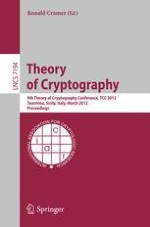This book constitutes the thoroughly refereed proceedings of the 9th Theory of Cryptography Conference, TCC 2012, held in Taormina, Sicily, Italy, in March 2012. The 36 revised full papers presented were carefully reviewed and selected from 131 submissions. The papers are organized in topical sections on secure computation; (blind) signatures and threshold encryption; zero-knowledge and security models; leakage-resilience; hash functions; differential privacy; pseudorandomness; dedicated encryption; security amplification; resettable and parallel zero knowledge.
